|
Restoration - The V-173 came from NASM with a set of very strict restoration requirements. Detailed instructions and requirements described very specifically how cleaning, preservation, fabric replacement, and painting were to be conducted. NASM’s primary goal is to restore their aircraft as close as possible to original, as fabricated condition.
Since the V-173 is 60 plus years old and is a very unusual design, there were some mysteries about its functionality. First, it was not known how the engines were started. The engines do not have electric starter motors and the propellers are too high off the ground for hand starting. Investigation of the bottom of the aircraft near an engine access panel revealed a small access door. This door was opened and inside there was an aluminum tube handle held in place by a spring clamp. The tube was pulled out of the clamp and out of the access hole. A strong pull on the tube caused the propeller to rotate! It was determined that one full pull rotated the crankshaft through one-quarter revolution (90 degrees), enough to start the engine.
The second mystery was location of the battery. NASM officials did not know where it was located. A search of both engine compartments and the cockpit revealed no battery. Later, a Vought worker was examining the cockpit. He noticed an electrical wire going from under the instrument panel, across the cockpit floor, and under the pilot’s seat. The wire led to an aluminum tube about 1.5 inch diameter. The tube contained two D-cell flashlight batteries believed to power only a low power radio, thus no battery for the aircraft systems!
Since there is only a top level drawing for the V-173, the first phase of the restoration was one of “discovery and documentation”, discover how the airplane is assembled and document the configuration. The insignia locations, access plate locations, paint lines, engine connections and etc. were all photographed and documented.
The engines and control surfaces were all removed and restored individually.
The V-173 airframe was fabricated in one piece, without typical manufacturing breaks. Because of its large size, it was necessary to place it in a vertical position to provide worker access to both top and bottom surfaces. A special rotisserie fixture was built that would hold the airframe in both horizontal and vertical positions. Scaffolding was used to provide access to all of the surface area.
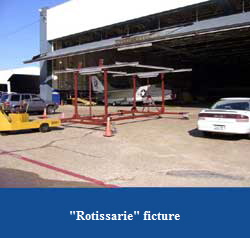 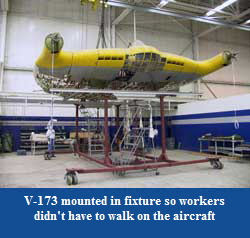
The next major step was to remove all of the remaining fabric skin covering. Fabric strips wrapped around and attached to the fore and aft wood stringers were removed as were cloth strips used as diagonal cross bracing. All of the wood internal structure was cleaned and preserved with a coating of varnish.
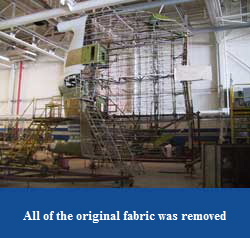 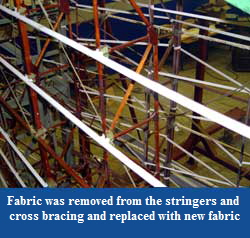
Re-covering the large surface area of the airframe was a major undertaking. Significant reverse engineering was conducted to reveal the original processes employed in skinning the aircraft. The methods revealed were completely unique and quite different from standard processes known to present day Vought experts in old aircraft restoration.
The apparent underlying design philosophy of this procedure was to provide a mechanical attachment of the external fabric cover to the airframe structure, eliminating any dependence on adhesives. This was accomplished by covering each fore and aft stringer with fabric which was tacked to the stringer at about one inch intervals on its inside surface. Rolls of untreated, mercerized cotton fabric, very similar to the original fabric, were obtained for this and skin replacement.
The skin was then hand stitched to the fabric sleeves with a double row of loop stitches along each stringer. Stitch spacing is typically 0.50 inch. Closure was completed by fabric tape application and doping.
To provide proof that this original concept could be successfully duplicated, Vought Heritage workers built a full scale mockup of a segment of the aircraft structure. Application of a coat of tautening nitrate dope and coats of non-tautening dope resulted in a very tight and smooth exterior finish. These results provided confidence in the ability to restore the “Pancake” to its original fabrication integrity.
Upper and lower surfaces of the aircraft were each covered with two large fabric sheets using the procedures described above. The covering was started in early 2007 and was completed in the fall of 2008. It was estimated that 83,000 stitches were required to complete the covering job!
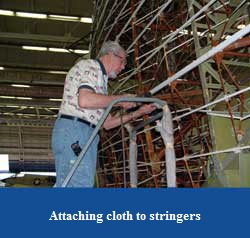 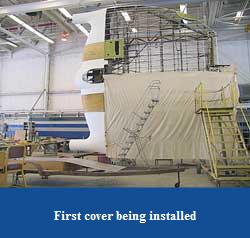
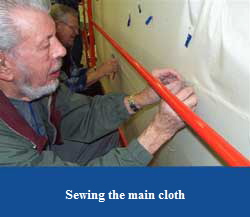 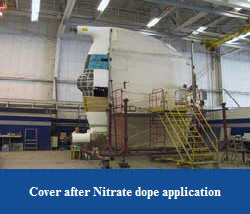
The aircraft was painted with a first coat of nitrate dope and subsequent coats of butyrate dope. A total of approximately thirteen coats were applied. Each paint coat is very light and the total paint thickness is about 7 mils (0.007 inch). Vertical tails and horizontal stabilizers were restored, covered, and painted in the same manner.
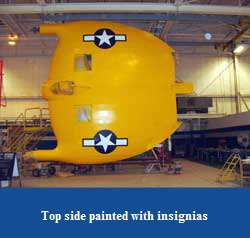 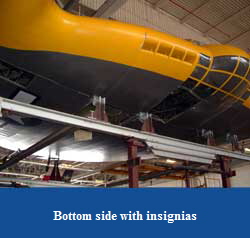
The main and tail wheel landing gears were disassembled, cleaned, painted, and then reassembled. The two engines were removed from the aircraft, disassembled, cleaned, lubricated, and reassembled. The four 90° gearboxes were in good condition and were not removed. The wood propellers were in good condition but did require refinishing. The cockpit was in good condition and only required cleaning and new seat upholstery. All of the original instruments except three were in the instrument panel. The three missing instruments were replaced.
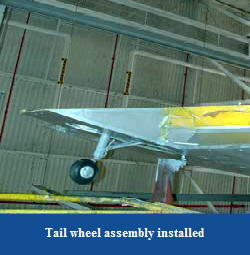 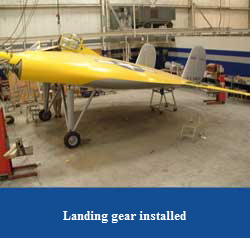
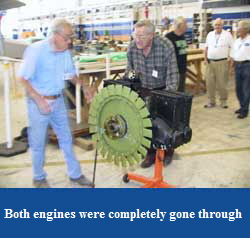 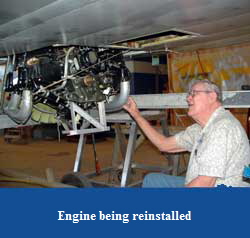
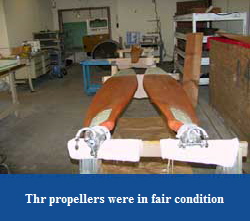 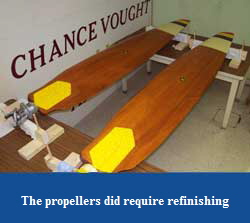
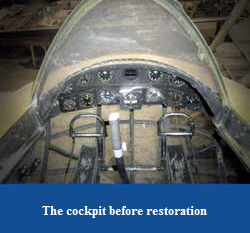 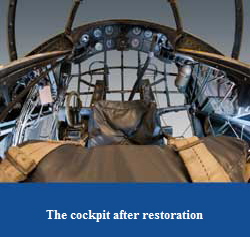
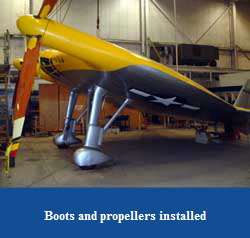 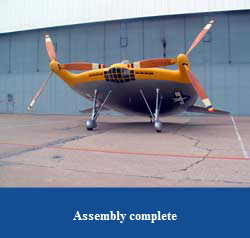
Select:
Owner - Background
Arrival
Current Status
Craftsman
Support
|